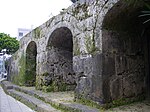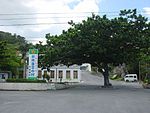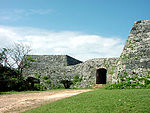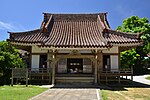Map all coordinates using OpenStreetMap
Download coordinates as:
This list is of the Cultural Properties of Japan designated in the category of structures (建造物, kenzōbutsu) for the Prefecture of Okinawa.
National Cultural Properties
As of 1 September 2017, twenty-three Important Cultural Properties with forty-one component structures have been designated, being of national significance.
Prefectural Cultural Properties
As of 31 July 2017, eighteen properties have been designated at a prefectural level.
Municipal Cultural Properties
As of 1 May 2016, thirty-five properties have been designated at a municipal level.
Registered Cultural Properties
As of 1 September 2017, eighty-two properties at thirty-four sites have been registered (as opposed to designated) at a national level.
| Property | Date | Municipality | Comments | Image | Coordinates | Ref. |
|---|---|---|---|---|---|---|
| Sunjagā 潮平ガー Sunjagā |
Taishō period | Itoman | 26°08′37″N 127°40′38″E / 26.14357724°N 127.67708825°E / 26.14357724; 127.67708825 (Sunjagā) | |||
| Minamidaitōjima West Port Former Boiler Hut 南大東島西港旧ボイラー小屋 Minamidaitōjima Nishikō kyū-boirā koya |
1924 | Minamidaitō | 25°50′33″N 131°13′05″E / 25.84261309°N 131.2180888°E / 25.84261309; 131.2180888 (Minamidaitōjima West Port Former Boiler Hut) | |||
| Kinjō Masuharu Family Residence 金城増治家住宅 Kinjō Masuharu-ke jūtaku |
1891 | Itoman | four registrations: main residence, pigpen, well, and stone wall | 26°06′20″N 127°41′29″E / 26.10556641°N 127.69142986°E / 26.10556641; 127.69142986 (Kinjō Masuharu Family Residence) | ||
| Kamiyama Family Residence 神山家住宅 Kamiyama-ke jūtaku |
1909-38 | Taketomi | four registrations: well and stone wall (1909), main residence (1912), and water tank (1938) | 24°14′08″N 124°00′47″E / 24.23549194°N 124.01308122°E / 24.23549194; 124.01308122 (Kamiyama Family Residence) | ||
| Former Tōyō Sugar Kitadaitō Branch 旧東洋製糖北大東出張所 kyū-Tōyō Seitō Kitadaitō shutchōjo |
1918 | Kitadaitō | 25°57′15″N 131°17′11″E / 25.95424453°N 131.28637094°E / 25.95424453; 131.28637094 (Former Tōyō Sugar Kitadaitō Branch) | |||
| West Pier 西桟橋 nishi sanbashi |
1938 | Taketomi | length of 105 metres (344 ft) and width of 4.4 metres (14 ft) |  |
24°19′54″N 124°04′47″E / 24.33157854°N 124.07977292°E / 24.33157854; 124.07977292 (West Pier) | |
| Iko Pier 伊古桟橋 Iko sanbashi |
1935 | Taketomi | length of 354 metres (1,161 ft) and width of 4.5 metres (15 ft) |  |
24°14′47″N 124°00′54″E / 24.24647713°N 124.01493053°E / 24.24647713; 124.01493053 (Iko Pier) | |
| Nagomi Tower なごみの塔 Nagomi no tō |
1953 | Taketomi | height of 4.5 metres (15 ft) |  |
24°19′50″N 124°05′07″E / 24.330614°N 124.08535858°E / 24.330614; 124.08535858 (Nagomi Tower) | |
| Former Kunigami Agricultural College Entrance 旧国頭農学校玄関 kyū-Kunigami nōgakkō genkan |
1902 | Nago | relocated in 1965 | 26°35′45″N 127°57′47″E / 26.595928°N 127.96312°E / 26.595928; 127.96312 (Former Kunigami Agricultural College Entrance) | ||
| Ōmori Family Residence 大盛家住宅 Ōmori-ke jūtaku |
1915 | Taketomi | four registrations: main residence, well, stone wall, and screen wall or hinpun (ヒンプン); on Kohama Island | 24°20′21″N 123°58′40″E / 24.33908289°N 123.9779037°E / 24.33908289; 123.9779037 (Ōmori Family Residence) | ||
| Former Tōyō Sugar Rock Phosphate Storage Facility 旧東洋製糖燐鉱石貯蔵庫 kyū-Tōyō Seitō rinkōseki chozōko |
1919 | Kitadaitō |  |
25°57′14″N 131°17′06″E / 25.954002°N 131.28511°E / 25.954002; 131.28511 (Former Tōyō Sugar Rock Phosphate Storage Facility) | ||
| Former Tōyō Sugar Rock Phosphate Cargo Pier 旧東洋製糖燐鉱石積荷桟橋 kyū-Tōyō Seitō rinkōseki tsumini sanbashi |
1919 | Kitadaitō | 25°57′14″N 131°17′03″E / 25.953951°N 131.284134°E / 25.953951; 131.284134 (Former Tōyō Sugar Rock Phosphate Cargo Pier) | |||
| Irifukuhama Family Residence 入福浜家住宅主屋 Irifukuhama-ke jūtaku shuoku |
Taishō period | Yonaguni | main residence; renovated in 2002 | 25°57′16″N 131°17′13″E / 25.95439912°N 131.28691762°E / 25.95439912; 131.28691762 (Irifukuhama Family Residence) | ||
| Ryūkyū Mura 琉球村 Ryūkyū mura |
end of Edo to Meiji period | Onna | seven registrations: Former Ōshiro Family Residence (旧大城家住宅) main residence (end of the Edo period), Former Higa Family Residence (旧比嘉家住宅) main residence (1877), Former Shimabukuro Family Residence (旧島袋家住宅) main residence and raised storehouse (1887), Former Tamanaha Family Residence (旧玉那覇家住宅) main residence (1891), Former Hirata Family Residence (旧平田家住宅) pigpen (1897), and Former Nishishigaki Family Residence (旧西石垣家住宅) main residence (end of Meiji period); all relocated in 1981/2 | 26°25′45″N 127°46′28″E / 26.429235°N 127.774307°E / 26.429235; 127.774307 (Ryūkyū Mura) | ||
| Aragaki Family Residence 新垣家住宅 Aragaki-ke jūtaku |
1896/1956 | Naha | six registrations: screen wall, pigpen, stone wall, and east and south ponds (1896) and main residence (1956) | 26°13′48″N 127°42′42″E / 26.22994602°N 127.71163602°E / 26.22994602; 127.71163602 (Aragaki Family Residence) | ||
| Iritakenishi Family Residence 入嵩西家住宅 Iritakenishi-ke jūtaku |
late Meiji period to 1948 | Ishigaki | four registrations: well (late Meiji period), main building (1911 renovated in 1955), screen wall (1914), and stone wall (1948) | 24°21′00″N 124°09′01″E / 24.3498725°N 124.15018708°E / 24.3498725; 124.15018708 (Iritakenishi Family Residence) | ||
| Ōno Drainage Tunnel 大野越排水溝 Ōno goshihai suikō |
1934 | Miyakojima | length of 640 metres (2,100 ft) | 24°48′21″N 125°19′28″E / 24.80580767°N 125.32438964°E / 24.80580767; 125.32438964 (Ōno Drainage Tunnel) | ||
| Former Tōyō Sugar Shimosaka Bathhouse 旧東洋製糖下阪浴場 kyū-Tōyō Seitō Shimosaka yokujō |
late Taishō period | Kitadaitō | two registrations: bathhouse and water tank | 25°57′17″N 131°17′15″E / 25.95474856°N 131.28758553°E / 25.95474856; 131.28758553 (Former Tōyō Sugar Shimosaka Bathhouse) | ||
| Former Tōyō Sugar Employee Bathhouse 旧東洋製糖社員浴場 kyū-Tōyō Seitō shain yokujō |
early Shōwa period | Kitadaitō | two registrations: bathhouse and water storage tank | 25°57′19″N 131°17′16″E / 25.95530611°N 131.28777294°E / 25.95530611; 131.28777294 (Former Tōyō Sugar Employee Bathhouse) | ||
| Sueyoshi Family Residence 末吉家住宅 Sueyoshi-ke jūtaku |
late Taishō period | Kitadaitō | two registrations: main residence and stone wall | 25°57′13″N 131°17′13″E / 25.95364259°N 131.28692356°E / 25.95364259; 131.28692356 (Sueyoshi Family Residence) | ||
| Tokuyama Family Residence 渡久山家住宅 Tokuyama-ke jūtaku |
1894 to early Shōwa period | Ishigaki | four registrations: pigpen and well (1894, the well was extended at the beginning of the Shōwa period), main residence (1925), and stone wall (beginning of the Shōwa period) | 24°20′35″N 124°09′37″E / 24.34319341°N 124.16019169°E / 24.34319341; 124.16019169 (Tokuyama Family Residence) | ||
| Kubura Family Residence 久部良家住宅 Kubura-ke jūtaku |
Meiji period | Yonaguni | two registrations: main residence (mid Meiji period, relocated in 1940) and stone wall (late Meiji period) | 24°28′02″N 123°00′17″E / 24.46708879°N 123.004707681762°E / 24.46708879; 123.004707681762 (Kubura Family Residence) | ||
| Yaeyama Minzoku-en 八重山民俗園 Yaeyama Minzoku-en |
1909/23 | Ishigaki | two registrations: Former Morita Family Residence (森田家住宅) main residence (1909, relocated in 1984) and Former Makishi Family Residence (旧牧志家住宅) main residence (1923, relocated in 1980) |   |
24°24′18″N 124°08′43″E / 24.40504168°N 124.14523866°E / 24.40504168; 124.14523866 (Yaeyama Minzoku-en) | |
| Nirokusō 弐六荘 Nirokusō |
1940 | Kitadaitō | 25°57′16″N 131°17′13″E / 25.95439912°N 131.28691762°E / 25.95439912; 131.28691762 (Nirokusō) | |||
| Tōgei Family Residence 東迎家住宅 Tōgei-ke jūtaku |
early Meiji period to 1953 | Yonaguni | five registrations: stone basin and well (early Meiji period, well renovated mid-Shōwa period); and main residence, water tank, and stone wall (1953, main residence renovated 1985) | 24°28′10″N 123°00′16″E / 24.46932551°N 123.00437733°E / 24.46932551; 123.00437733 (Tōgei Family Residence) | ||
| Okinawa World おきなわワールド Okinawa wārudo |
late Meiji period to 1934 | Nanjō | five registrations: Former Irei Family Residence (旧伊礼家住宅) main residence, Former Kyan Family Residence (旧喜屋武家住) main residence, and Former Taba Family Residence (旧田場家住宅) main residence (all late Meiji period); Former Chinen Family Residence (旧知念家住宅) pigpen (1897); and Former Uezato Family Residence (旧上里家住宅) main residence (1934); all relocated in 1995/6 | 26°08′19″N 127°45′04″E / 26.13862232°N 127.7511093°E / 26.13862232; 127.7511093 (Yagi Family Residence) | ||
| Yagi Family Residence 屋宜家住宅 Yagi-ke jūtaku |
1915 | Taketomi | five registrations: main residence, screen wall, and well (1952); stone wall (1952, renovated 1954), and annexe (1955) | 26°07′38″N 127°44′13″E / 26.12733247°N 127.73694047°E / 26.12733247; 127.73694047 (Yagi Family Residence) | ||
| Okinawa City Furusato-en 沖縄市立ふるさと園 Okinawa shiritsu Furusato-en |
1924 | Okinawa | three registrations: Former Kuba Family Residence (旧久場家住宅) main residence and screen wall and Former Hirata Family Residence (旧平田家住宅) pigpen (all relocated in 1985/6) | 26°19′41″N 127°48′15″E / 26.32792961°N 127.8042596°E / 26.32792961; 127.8042596 (Okinawa City Furusato-en) | ||
| Chatan Uchinā Family Residence 北谷町うちなぁ家 主屋, ふーる Chatan-chō Uchinā-ya |
Meiji period | Chatan | two registrations: main residence (1898, relocated in 2005) and pigpen (early Meiji period, relocated in 2006) | 26°19′40″N 127°46′06″E / 26.32781128°N 127.76825958°E / 26.32781128; 127.76825958 (Chatan Uchinā Family Residence) | ||
| Former Nishinaka Sugar Cooperative Refinery Chimney 旧西中共同製糖場煙突 kyū-Nishinaka kyōdō seitō jōentotsu |
1942 | Miyakojima | height of 13 metres (43 ft) | 24°48′21″N 125°16′50″E / 24.80596944°N 125.28068888°E / 24.80596944; 125.28068888 (Former Nishinaka Sugar Cooperative Refinery Chimney) | ||
| Misatomura Residence 美里村屋 Misatomura-ya |
1954 | Okinawa | renovated in 1974 | 26°20′47″N 127°48′53″E / 26.34643277°N 127.81469194°E / 26.34643277; 127.81469194 (Misatomura Residence) | ||
| Former Kokuba Family Residence 旧國場家住宅 kyū-Kokuba-ke jūtaku |
1930 | Onna | main residence; renovated in 2011 | 26°25′45″N 127°46′28″E / 26.429232°N 127.774497°E / 26.429232; 127.774497 (Former Kokuba Family Residence) | ||
| Ishigaki Yaima Mura 石垣やいま村 Ishigaki Yaima-mura |
1907/1923 | Ishigaki | Former Ōhama Family Residence (1907) and Former Kishaba Family Residence (1923), both renovated in 2008 |   |
24°24′14″N 124°08′39″E / 24.40375322°N 124.14414586°E / 24.40375322; 124.14414586 (Ishigaki Yaima Mura) | |
| Former Nashiro Family Residence 旧名城家住宅 kyū-Nashiro-ke jūtaku |
1905 | Izena | two registrations: main building and stone wall | 26°55′51″N 127°55′33″E / 26.930952°N 127.925864°E / 26.930952; 127.925864 (Former Nashiro Family Residence) |
| Cultural Properties of Japan - structures | ||
|---|---|---|
| National Treasures |    | |
| Important Cultural Properties | ||
| Hokkaidō | ||
| Tōhoku | ||
| Kantō | ||
| Chūbu | ||
| Kansai | ||
| Chūgoku | ||
| Shikoku | ||
| Kyūshū | ||
| Okinawa | ||
| Cultural Properties of Japan - Okinawa Prefecture | ||
|---|---|---|
| Tangible Cultural Properties |   | |
| Intangible Cultural Properties | ||
| Folk Cultural Properties | ||
| Monuments | ||
| Cultural Landscapes | N/A | |
| Groups of Traditional Buildings | ||
| Conservation Techniques |
| |
See also
- Cultural Properties of Japan
- National Treasures of Japan
- List of Historic Sites of Japan (Okinawa)
- Ryūkyū Kingdom
- Hague Convention for the Protection of Cultural Property in the Event of Armed Conflict
References
- "Cultural Properties for Future Generations". Agency for Cultural Affairs. Retrieved 23 September 2017.
- 国宝・重要文化財 [Number of National Treasures and Important Cultural Properties by Prefecture] (in Japanese). Agency for Cultural Affairs. 1 September 2017. Retrieved 23 September 2017.
- ^ "Database of National Cultural Properties: 国宝・重要文化財(建造物) (沖縄県)" (in Japanese). Agency for Cultural Affairs. Archived from the original on 2 May 2017. Retrieved 23 September 2017.
- ^ 国・県・市町村指定文化財 [National, Prefectural, and Municipal Cultural Properties] (PDF) (in Japanese). Okinawa Prefecture. 1 May 2016. Retrieved 23 September 2017.
- ^ "Gusuku Sites and Related Properties of the Kingdom of Ryukyu". UNESCO. Retrieved 23 September 2017.
- 都道府県別指定等文化財件数(都道府県分) [Number of Prefectural Cultural Properties by Prefecture] (in Japanese). Agency for Cultural Affairs. 1 May 2017. Retrieved 23 September 2017.
- 金城ダムと文化財 [Kinjo Dam and Related Cultural Properties] (in Japanese). Okinawa Prefecture. 26 December 2012. Retrieved 22 January 2015.
- 都道府県別指定等文化財件数(市町村分) [Number of Municipal Cultural Properties by Prefecture] (in Japanese). Agency for Cultural Affairs. 1 May 2017. Retrieved 23 September 2017.
- "勝連の「吉本家」全焼 うるま市指定文化財". 47NEWS(Ryūkyū Shimpō). Retrieved 5 October 2015.
- 建造物 [Structures] (in Japanese). Miyakojima City. Retrieved 22 January 2015.
- 登録文化財 [Number of Registered Cultural Properties by Prefecture] (in Japanese). Agency for Cultural Affairs. 1 September 2017. Retrieved 23 September 2017.
External links
- (in Japanese) Cultural Properties in Okinawa Prefecture
- (in Japanese) List of Cultural Properties in Okinawa Prefecture


































